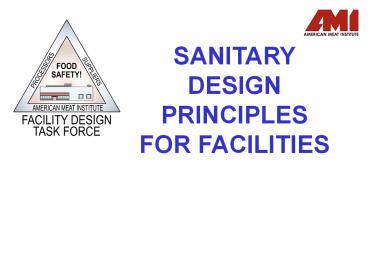SANITARY DESIGN PRINCIPLES FOR FACILITIES - PowerPoint PPT Presentation
Title:
SANITARY DESIGN PRINCIPLES FOR FACILITIES
Description:
6. Site Elements Facilitate Sanitary Conditions ... and water management systems to facilitate sanitary conditions for the site. ... – PowerPoint PPT presentation
Number of Views:820
Avg rating:3.0/5.0
Title: SANITARY DESIGN PRINCIPLES FOR FACILITIES
1
SANITARY DESIGN PRINCIPLES FOR FACILITIES
2
ZONES OF CONTROL
3
PRINCIPLES OF SANITARY DESIGN
- 1. Distinct Hygienic Zones Established In The
Facility - Maintain strict physical separations that reduce
the likelihood of transfer of hazards from one
area of the plant, or from one process, to
another area of the plant or process,
respectively. Facilitate necessary storage and
management of equipment, waste and temporary
clothing to reduce the likelihood of transfer of
hazards.
4
PRINCIPLES OF SANITARY DESIGN
- 2. Control the movement of personnel and
materials flows to reduce hazards - Establish traffic and process flows that control
the movement of production workers, managers,
visitors, QA staff, sanitation and maintenance
personnel, products, ingredients, rework and
packaging materials to reduce food safety risks.
5
KEEP IT COLD CONTROL MOISTURE
6
3. Water Accumulation Controlled Inside the
Facility
PRINCIPLES OF SANITARY DESIGN
Design and construct a building system (floors,
walls, ceilings, and supporting infrastructure)
that prevents the development and accumulation of
water. Ensure that all water positively drains
from the process area and that these areas will
dry during the allotted time frames.
7
4. Room Temperature Humidity Controlled
PRINCIPLES OF SANITARY DESIGN
Control room temperature and humidity to
facilitate control of microbial growth. Keeping
process areas cold and dry will reduce the
likelihood of growth of potential food borne
pathogens. Ensure that the HVAC/refrigeration
systems serving process areas will maintain
specified room temperatures and control room air
dew point to prevent condensation. Ensure that
control systems include a cleanup purge cycle
(heated air make-up and exhaust) to manage fog
during sanitation and to dry out the room after
sanitation.
8
5. Room Air Flow Room Air Quality Controlled
PRINCIPLES OF SANITARY DESIGN
Design, install and maintain HVAC/refrigeration
systems serving process areas to ensure air flow
will be from more clean to less clean areas,
adequately filter air to control contaminants,
provide outdoor makeup air to maintain specified
airflow, minimize condensation on exposed
surfaces, and capture high concentrations of
heat, moisture and particulates at their source.
9
FACILITATE SANITATION
10
PRINCIPLES OF SANITARY DESIGN
- 6. Site Elements Facilitate Sanitary Conditions
- Provide site elements such as exterior grounds,
lighting, grading and water management systems to
facilitate sanitary conditions for the site.
Control access to and from the site.
11
PRINCIPLES OF SANITARY DESIGN
- 7. Building Envelope Facilitates Sanitary
Conditions - Design and construct all openings in the
building envelope (doors, fans, louvers and
utility penetrations) so that insects and rodents
have no harborage around the building perimeter,
easy route into the facility, or harborage inside
the building. Design and construct envelope
components to enable easy cleaning and
inspection.
12
PRINCIPLES OF SANITARY DESIGN
8. Interior Spatial Design Promotes
Sanitation Provide interior spatial design
that enables cleaning, sanitation and maintenance
of building components and processing equipment
13
PRINCIPLES OF SANITARY DESIGN
- Building Components Construction Facilitate
Sanitary Conditions - Design building components to prevent harborage
points, ensuring sealed joints and the absence of
voids. Facilitate sanitation by using durable
materials and isolating utilities with
interstitial spaces and stand offs
14
PRINCIPLES OF SANITARY DESIGN
- 10. DESIGN UTILITY SYSTEMS TO PREVENT
CONTAMINATION - Design and install utility systems to prevent
the introduction of food safety hazards by
providing surfaces that are cleanable to a
microbiological level, using appropriate
construction materials, providing access for
cleaning , inspection and maintenance, preventing
water collection points, and preventing niches
and harborage points
15
PRINCIPLES OF SANITARY DESIGN
- 11. SANITATION INTEGRATED INTO FACILITY DESIGN
- Provide proper sanitation systems to eliminate
the chemical, physical and microbiological
hazards existing in a food plant environment































